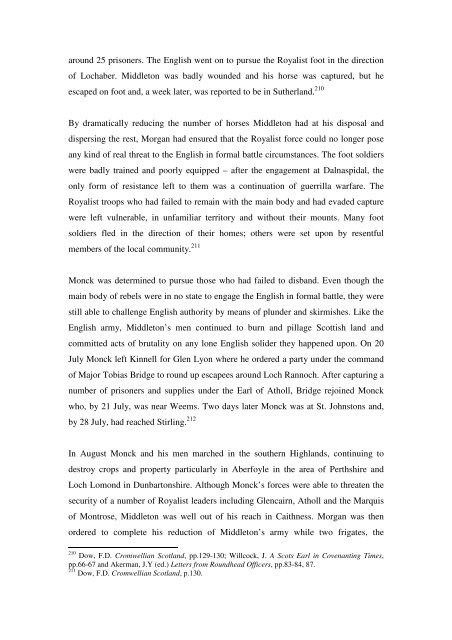The Glencairn Uprising, 1653-54 Helen Baker Department of ...
The Glencairn Uprising, 1653-54 Helen Baker Department of ...
The Glencairn Uprising, 1653-54 Helen Baker Department of ...
You also want an ePaper? Increase the reach of your titles
YUMPU automatically turns print PDFs into web optimized ePapers that Google loves.
around 25 prisoners. <strong>The</strong> English went on to pursue the Royalist foot in the direction<br />
<strong>of</strong> Lochaber. Middleton was badly wounded and his horse was captured, but he<br />
escaped on foot and, a week later, was reported to be in Sutherland. 210<br />
By dramatically reducing the number <strong>of</strong> horses Middleton had at his disposal and<br />
dispersing the rest, Morgan had ensured that the Royalist force could no longer pose<br />
any kind <strong>of</strong> real threat to the English in formal battle circumstances. <strong>The</strong> foot soldiers<br />
were badly trained and poorly equipped – after the engagement at Dalnaspidal, the<br />
only form <strong>of</strong> resistance left to them was a continuation <strong>of</strong> guerrilla warfare. <strong>The</strong><br />
Royalist troops who had failed to remain with the main body and had evaded capture<br />
were left vulnerable, in unfamiliar territory and without their mounts. Many foot<br />
soldiers fled in the direction <strong>of</strong> their homes; others were set upon by resentful<br />
members <strong>of</strong> the local community. 211<br />
Monck was determined to pursue those who had failed to disband. Even though the<br />
main body <strong>of</strong> rebels were in no state to engage the English in formal battle, they were<br />
still able to challenge English authority by means <strong>of</strong> plunder and skirmishes. Like the<br />
English army, Middleton’s men continued to burn and pillage Scottish land and<br />
committed acts <strong>of</strong> brutality on any lone English solider they happened upon. On 20<br />
July Monck left Kinnell for Glen Lyon where he ordered a party under the command<br />
<strong>of</strong> Major Tobias Bridge to round up escapees around Loch Rannoch. After capturing a<br />
number <strong>of</strong> prisoners and supplies under the Earl <strong>of</strong> Atholl, Bridge rejoined Monck<br />
who, by 21 July, was near Weems. Two days later Monck was at St. Johnstons and,<br />
by 28 July, had reached Stirling. 212<br />
In August Monck and his men marched in the southern Highlands, continuing to<br />
destroy crops and property particularly in Aberfoyle in the area <strong>of</strong> Perthshire and<br />
Loch Lomond in Dunbartonshire. Although Monck’s forces were able to threaten the<br />
security <strong>of</strong> a number <strong>of</strong> Royalist leaders including <strong>Glencairn</strong>, Atholl and the Marquis<br />
<strong>of</strong> Montrose, Middleton was well out <strong>of</strong> his reach in Caithness. Morgan was then<br />
ordered to complete his reduction <strong>of</strong> Middleton’s army while two frigates, the<br />
210 Dow, F.D. Cromwellian Scotland, pp.129-130; Willcock, J. A Scots Earl in Covenanting Times,<br />
pp.66-67 and Akerman, J.Y (ed.) Letters from Roundhead Officers, pp.83-84, 87.<br />
211 Dow, F.D. Cromwellian Scotland, p.130.
















